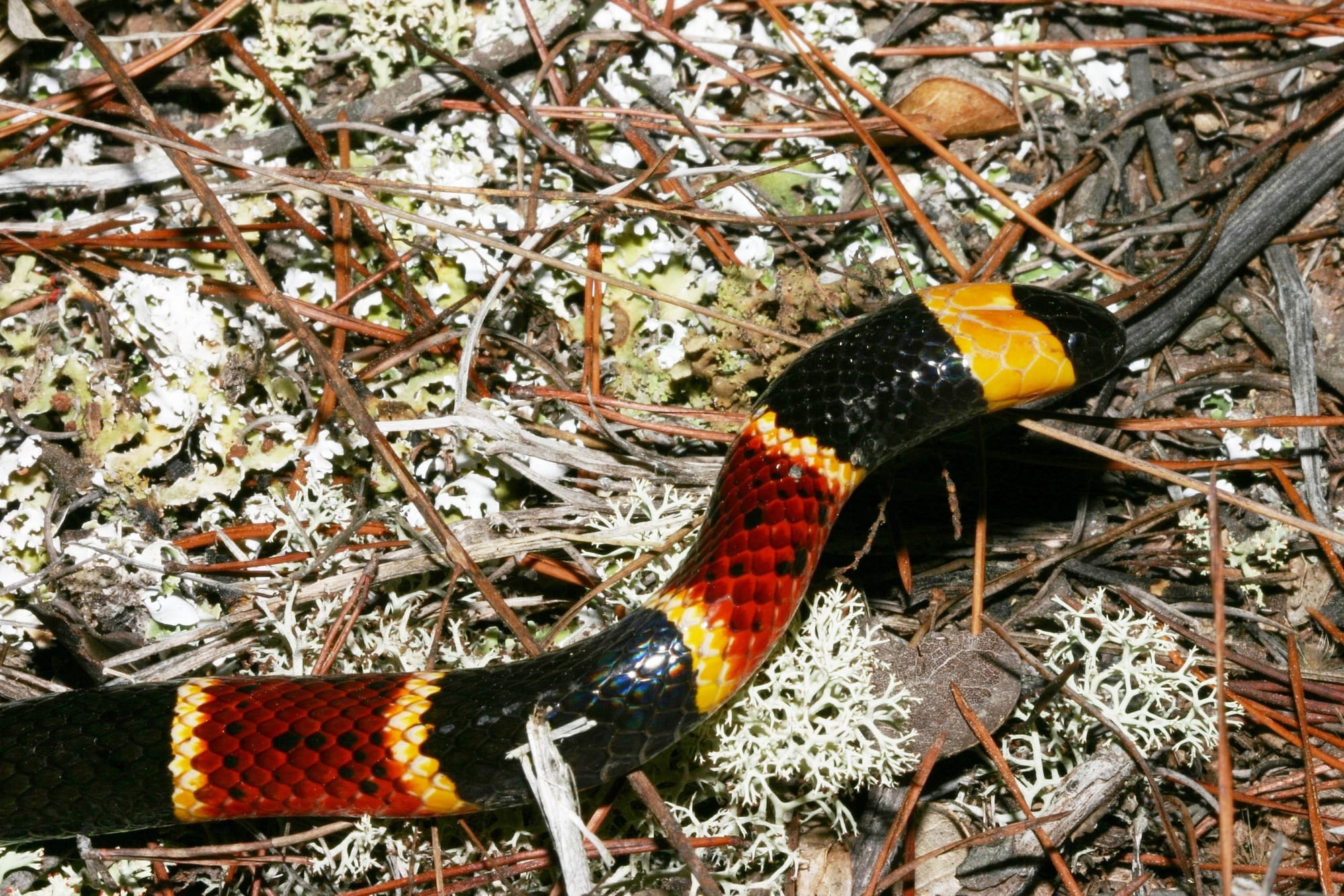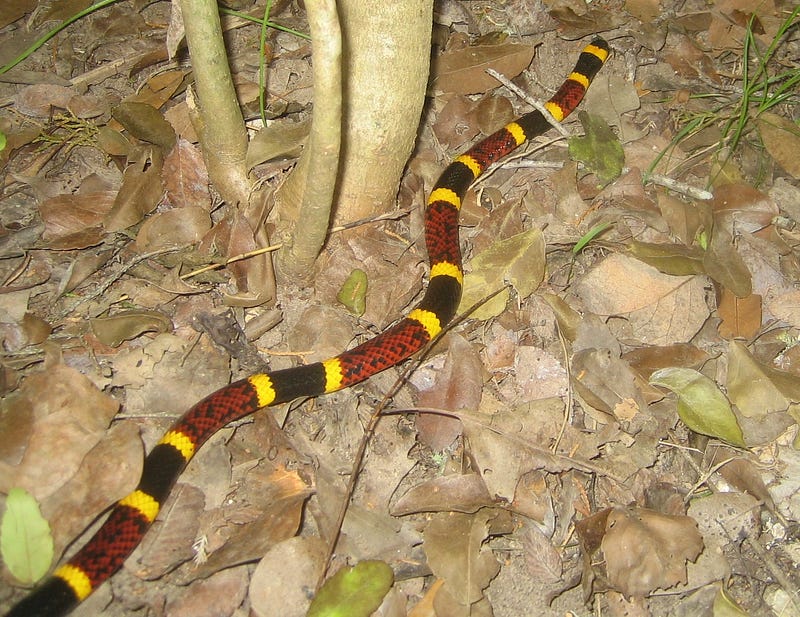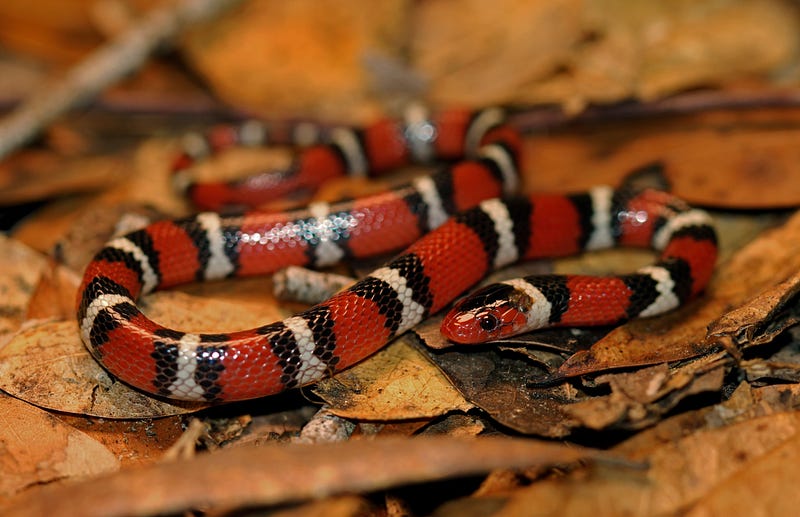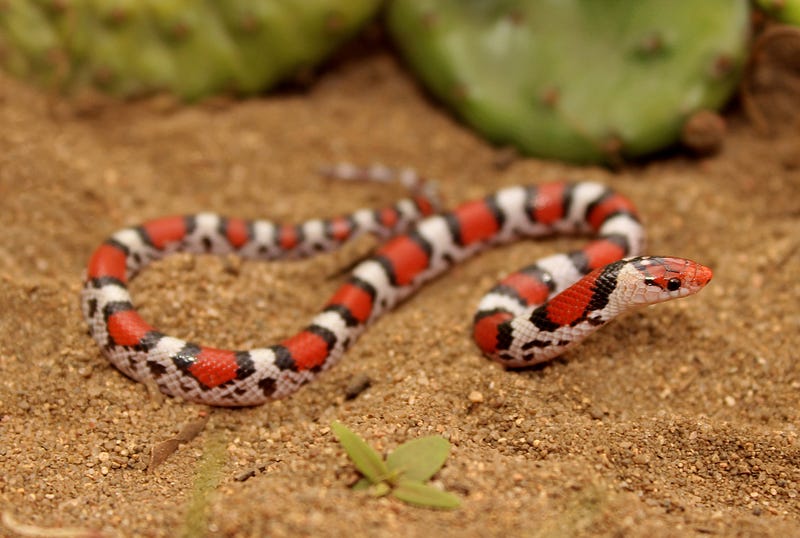
Our first story of Season 4 is a well known example of mimicry. Perhaps, too well known. This set of species has become the subject of a common and simple rhyme. Unfortunately, the rhyme is so common and so simple that many people actually mess up the order. Thankfully, the species it warns against is not as common as the rhyme and is generally shy and not aggressive.
As you might have guessed from the picture above, this is about the eastern coral snake, Micrurus fulvius, a classic example of defensive mimicry. For those who are curious, I have heard several different varieties on the same theme, but the form I originally learned went as follows:
“Red touching black, you’re ok Jack. Red touching yellow, you’re a dead fellow.”
My usual recommendation to people is not to try and memorize the rhyme, in whatever form, for two main reasons. Firstly, you will likely not be able to remember it correctly in the heat of the moment and potentially make an error, but even more importantly, it’s not really necessary. Coral snakes are generally docile and will usually flee from threats. To a snake, a human is a dangerous predator. Furthermore, venomous snakes use their venom to kill their prey and it takes a lot of energy to make.
Coral snake bites are rare and usually happen to people who pick up the snake, putting its mouth in range of their fingers. You don’t need a rhyme to know not to pick up wild snakes. Even if they aren’t venomous, a snake mouth is full of bacteria and can still cause an infection. Coral snakes also cannot control their venom amounts as much as other snakes and dry bites are common. There has only been one known fatality from this snake since the 1960s, when the coral snake antivenin was developed. This occurred in 2006 because the victim failed to seek proper medical attention. Coral snake venom is a potent neurotoxin, attacking the nervous system and shutting down the heart and lungs, but is actually one one of the least dangerous venomous snakes in North America despite its potency.
However, I believe that the example of the rhyme and its misconceptions are an excellent illustration of how defensive mimicry works and its effectiveness in nature. There are a large number of coral snake mimic species, partly because there are a number of different species throughout the world known as ‘coral snakes’. For Micrurus fulvius, two of the primary mimics are the scarlet snake, Cemophora coccinea, and the scarlet kingsnake, Lampropeltis elapsoides. All three have an alternating pattern of red, black, and yellow (or whitish) stripes. Do you think you can tell the difference just by looking? I’m going to show a picture of each one below. See if you can tell which one of the dangerous venomous snake without looking at the captions.



How did you do? Not easy, is it? The top picture is the eastern coral snake, the middle one is the scarlet king snake, and the third is the scarlet snake. Now imagine you are a predator and your life depends on you picking correctly. The strategy of dangerous prey ‘advertising’ their unappetizing nature with bright colors is widespread. Predators avoid these species, which leaves a perfect niche for a mimic to take advantage. By appearing similar to the dangerous species, they can also go unmolested by most predators.
However, bright colors are non-adaptive for predator avoidance in the absence of such a relationship. Biologists have tested the habituation of predators to coral snakes, or the lack thereof, using painted and drab models and documenting attacks by birds of prey. In areas where the eastern coral snake is native, the painted models were avoided, but in areas with no native coral snakes or mimics, predators immediately honed in on the bright models while the drab models remained camouflaged and less targeted. The birds there had never encountered a coral snake, so had no reason to avoid attacking it.
This is the main point of defensive mimicry of this sort: to take advantage of negative interactions between other species in order to avoid predation or parasites. This is not something that the mimic species have done constantly. Natural selection is a powerful force. It is not random, but deterministic. Any heritable trait which increases survival or reproduction will be more likely to be passed down to future generations. This is true for all of the mimicry examples this season. The more similar a mimic is to the original, the more advantage it can potentially reap.
The human rhyme about coral snakes is, in some ways, another form of adaptation to increase survival, this time using our well-developed mental capacities to come up with more effective ways of differentiating between a mimic species and the original. The entire interaction fascinates me. As Season 4 progresses, think about the evolutionary processes that brought about these interactions, but also understand that we are not separate from these and nature in general, but a part of them.
Again, if you like my stories, please like, subscribe, and share them. If you have an idea for a topic for a future season, let me know and if I use it, I’ll give you a shout out in my introductory post.